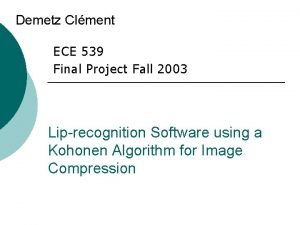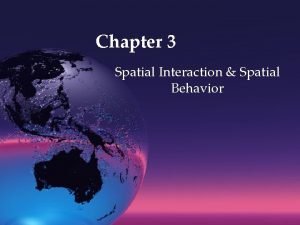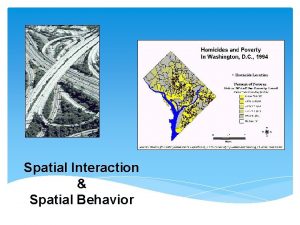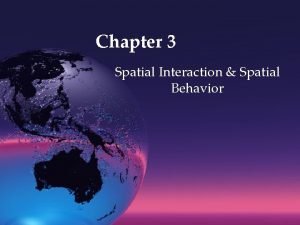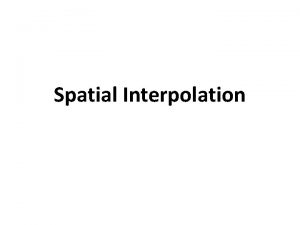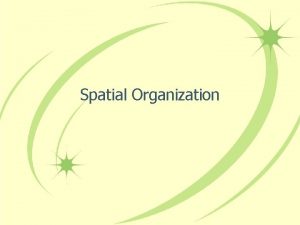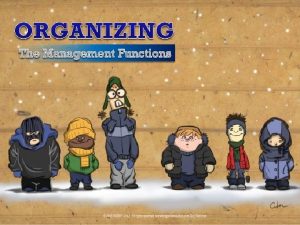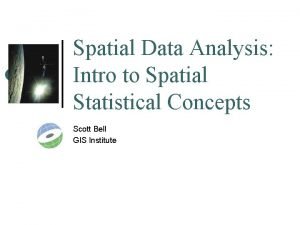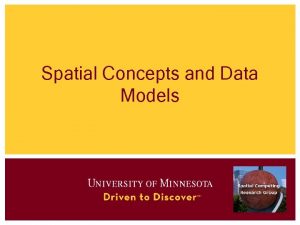SPATIAL CONCEPTS Spatial concepts are the organising concepts





















- Slides: 21

SPATIAL CONCEPTS Spatial concepts are the organising concepts common to all branches of geography. Although there are many organising concepts, there are nine commonly recognised concepts:

WHAT ARE THE SPATIAL CONCEPTS? v direction v movement v distance v spatial association v location v scale v region v spatial change over time v spatial interaction v distribution (spatial)

SPATIAL CONCEPTS Are tools which should be used to describe the geographic characteristics of an environment. You can use the following acronym to remember the spatial concepts: MR SCOT SAID LSD You need to be able to remember the spatial concepts and know how to use and identify each

MOVEMENT: INVOLVES THE CHANGE IN LOCATION OF ONE OR MORE PHENOMENA ACROSS THE EARTH’S SURFACE. IT MAY INVOLVE THE MOVEMENT OF WATER, AIR, SEDIMENTS, TRAFFIC, PEOPLE, MONEY, TRADE ETC

MOVEMENT

REGION An area which shares at least one human or natural geographic characteristic which distinguishes itself from other regions. It can refer to a variety of scales, from local to encompassing several countries

REGION

SPATIAL CHANGE OVER TIME The degree to which a place or phenomena has changed its spatial characteristics (location or distribution) features (human or natural) or pattern of use over time.

SCOT

SPATIAL INTERACTION The nature of the links between phenomena and places. It is the degree to which they influence and interact with each other over space through a natural process or human activity for example through the movement of people, flow of water, emission of pollution etc.

SPATIAL INTERACTION

SPATIAL ASSOCIATION: The degree to which the distribution of two phenomena overlap in space Strong Medium Weak None

SPATIAL ASSOCIATION

SPATIAL DISTRIBUTION The arrangement of phenomena on (or near) the earth’s surface. One feature or place has a location; the arrangement of many features over space is its distribution.

DISTRIBUTION

LOCATION: IS WHERE A FEATURE IS FOUND ON THE EARTH’S SURFACE. EACH PLACE HAS AN ABSOLUTE AND A RELATIVE LOCATION.

LOCATION

SCALE: INCLUDES DISTANCE SCALES AND THE IMPORTANCE OF THE PHENOMENA OR THE SIZE OF THE RESPONSE OR PHENOMENA: LOCAL, REGIONAL, NATIONAL, INTERNATIONAL, GLOBAL

SCALE

DISTANCE: A MEASUREMENT OF THE SPACE BETWEEN TWO PLACES. IT INCLUDES THE CONCEPTS OF ABSOLUTE (LINEAR) DISTANCE, RELATIVE DISTANCE (THE TIME IT TAKES TO TRAVEL), AND PSYCHOLOGICAL DISTANCE.

DISTANCE
 Antigentest åre
Antigentest åre Self organising map
Self organising map Concept of organising
Concept of organising Planning, organizing, directing and controlling are the
Planning, organizing, directing and controlling are the Lambini and sons
Lambini and sons Organizing seminars and conferences
Organizing seminars and conferences Directing function of management
Directing function of management Planning skills in the workplace
Planning skills in the workplace What is a project schedule
What is a project schedule Oflinemaps
Oflinemaps Thế nào là mạng điện lắp đặt kiểu nổi
Thế nào là mạng điện lắp đặt kiểu nổi Các loại đột biến cấu trúc nhiễm sắc thể
Các loại đột biến cấu trúc nhiễm sắc thể Bổ thể
Bổ thể Vẽ hình chiếu đứng bằng cạnh của vật thể
Vẽ hình chiếu đứng bằng cạnh của vật thể Phản ứng thế ankan
Phản ứng thế ankan Các môn thể thao bắt đầu bằng tiếng nhảy
Các môn thể thao bắt đầu bằng tiếng nhảy Khi nào hổ con có thể sống độc lập
Khi nào hổ con có thể sống độc lập điện thế nghỉ
điện thế nghỉ Một số thể thơ truyền thống
Một số thể thơ truyền thống Thế nào là sự mỏi cơ
Thế nào là sự mỏi cơ Trời xanh đây là của chúng ta thể thơ
Trời xanh đây là của chúng ta thể thơ Số.nguyên tố
Số.nguyên tố

